Sustainable forest
People in the Netherlands use a lot of wood every year, for paper, window frames, firewood, fences, etc. Some of this wood is grown in the Netherlands. Wageningen researchers are conducting a large-scale experiment to find out how wood production can be made more sustainable. They study the impact that harvesting more or fewer trees has on carbon sequestration and the absorption and release of nutrients such as phosphorus and potassium in the soil and the wood. They want to use this knowledge to make forests more resilient and climate-resistant. Do you think that wood production is compatible with creating sustainable forests?
The Netherlands has little space and few forests. “Since our country is located in a delta, we have one of the smallest wooded areas of Europe. Furthermore, our country is densely populated and there is a lot of agriculture,” says Frank Sterck, Associate Professor of Forest Ecology in Wageningen. We also want to do all sorts of things with the little bit of forest we do have. “We want to provide space for nature, recreation, and water management. At the same time, carbon sequestration in forests is becoming increasingly important to mitigate climate change.”
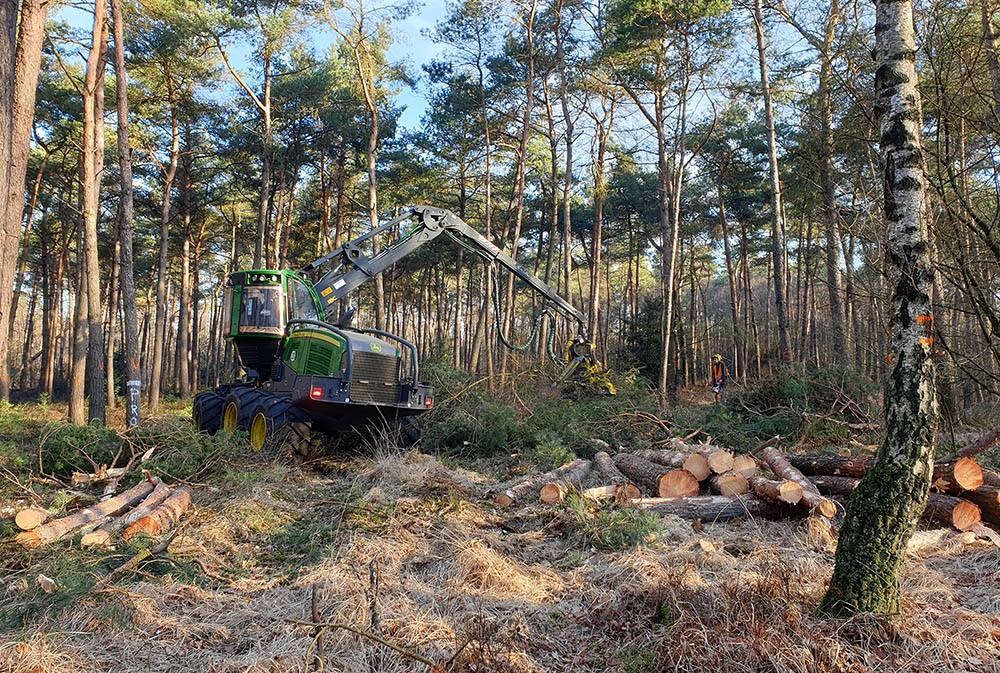
We also harvest wood from our forests for raw material – Photo: Marleen Vos
We also harvest wood from our forests for raw material. “Many of the forests were originally planted for wood production. The same forests are visited daily by hordes of people who want to enjoy nature. The need to create resilient forests therefore serves several different purposes,” explains Sterck.
Survival chances
The forests are also under threat from climate change. “The heat causes the trees to transpire more and they are then quicker to extract water from the soil. If summers also get drier, then the trees will be in trouble,” outlines Sterck. The growth of trees also slows down in drier circumstances. Many Dutch forests are still suffering the consequences of the dry, hot summer of 2018. “For example, Douglas firs have lost a lot of needles and have not recovered yet. I really dread to think of what the consequences would be of another summer like that.” “It is of the utmost importance that we have resilient forests to increase the survival rates of forests,” Sterck emphasises.
“ Forests are a sustainable source of raw materials, but when using it, you need to consider how to sustain the system in the long term. And here we’re talking centuries.”
Pine, fir, and beech
To research the best and most sustainable way to manage forests, a large partnership was established with forest owners and forest management, such as the National Forest Service (Staatsbosbeheer), the Union of Private Forest Owner Groups (Unie van Bosgroepen), and National Park de Hoge Veluwe (Het Nationale Park De Hoge Veluwe). The research is conducted by Wageningen University & Research and is funded by the national research council, the Netherlands Organisation for Scientific Research (NWO), which attaches great importance to research into sustainable wood harvesting. We do not yet know the exact consequences of harvesting trees. How fast do trees grow back? What impact does this have on carbon sequestration and nutrients? What is the best number of trees to remove?
A large-scale experiment was started in the spring of 2019 to answer these questions. Five areas in the Veluwe and North Brabant were selected, with three locations of 1 hectare each, featuring Scots pine, Douglas fir, or beech. These types of trees are often harvested for wood production. This comes to 15 locations in total. Every location is divided into quarters. For one quarter, all the trees remain, while for the other quarters, one-third, two-thirds, or all the trees are harvested.
Nutrients
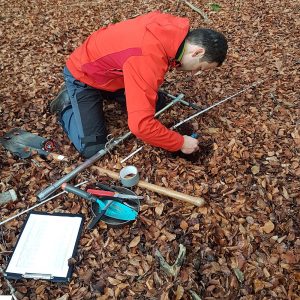
Soil investigation before the trees are harvested – Photo: Marleen Vos
“A forest that is a little bit more open can possibly create opportunities,” says Sterck. Rainwater and air streams bring with them scarce nutrients such as phosphorus and potassium. These nutrients are collected by the forest and end up in the soil, where they are absorbed by the roots of plants and trees. A forest with slightly fewer trees can collect more nutrients. This can be essential for forests growing in poor sandy soil, such as in the Veluwe, North Brabant, and Twente. In addition, trees also absorb more light and have access to more water in a more open forest. “But if you remove too many trees, there is a greater risk of nutrient leaching,” Sterck warns. In that case, the nutrients are not used, but are deposited deeper in the soil and eventually end up in the groundwater.
Branches and topsoil
Previously, branches were left after the harvest, but these days, the treetops and branches are also removed to be used as wood chips for power stations. During the experiment, researchers will look at the impact this has on the recovery of the forest and the nutrients in the soil. The forest users also shake and grind the top layer of the soil with machines, so-called tilling. They do this to encourage the establishment of new seedlings. “However, the risk is that if there are not enough large trees to absorb the nutrients, they will leach out quicker and will no longer be available. Therefore, the question is whether this tilling is such a good idea,” notes Sterck.
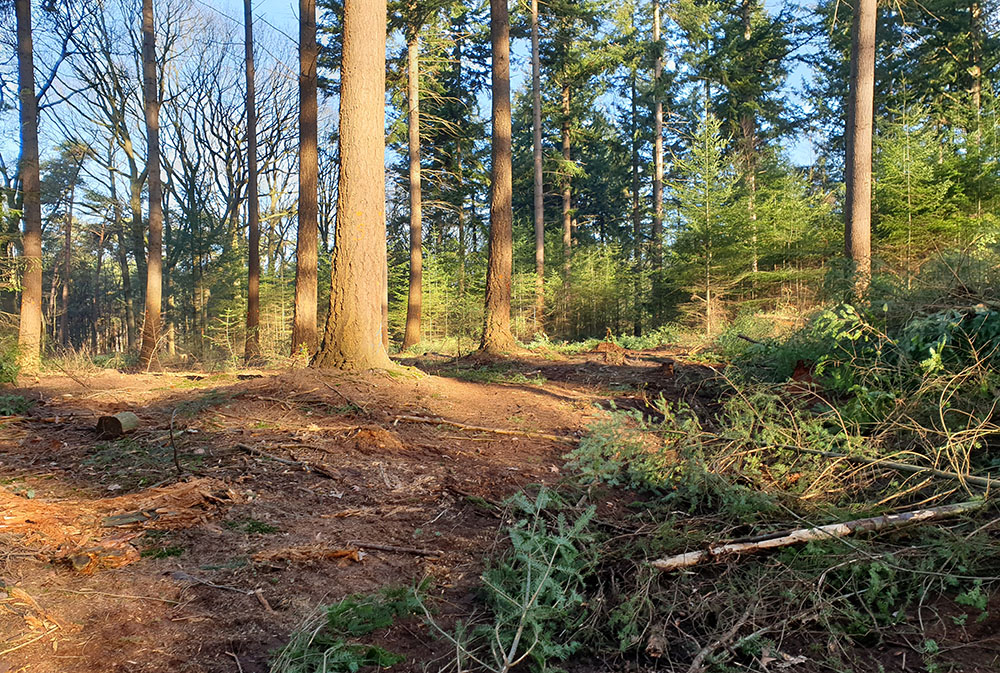
Douglas forest after harvest, with branches and topwood on the right and everything removed on the left – Photo: Marleen Vos
Weighing and measuring
At the start of the experiment, in February and March 2019, the trees were cut and the volume of wood was weighed with the help of students. The amount and type of nutrients were also measured. “This is how we can determine the biomass and nutrients that are taken from the system during a harvest,” explains Sterck. In the next two years, measurements will reveal the collection and leaching of nutrients in the soil. “We are looking for the optimal balance between the harvest volume and the reserves of available nutrients. I expect that a relatively small-scale intervention is best for sustainable production in the long-term and will lead to resilient forests and sufficient carbon sequestration,” says Sterck.
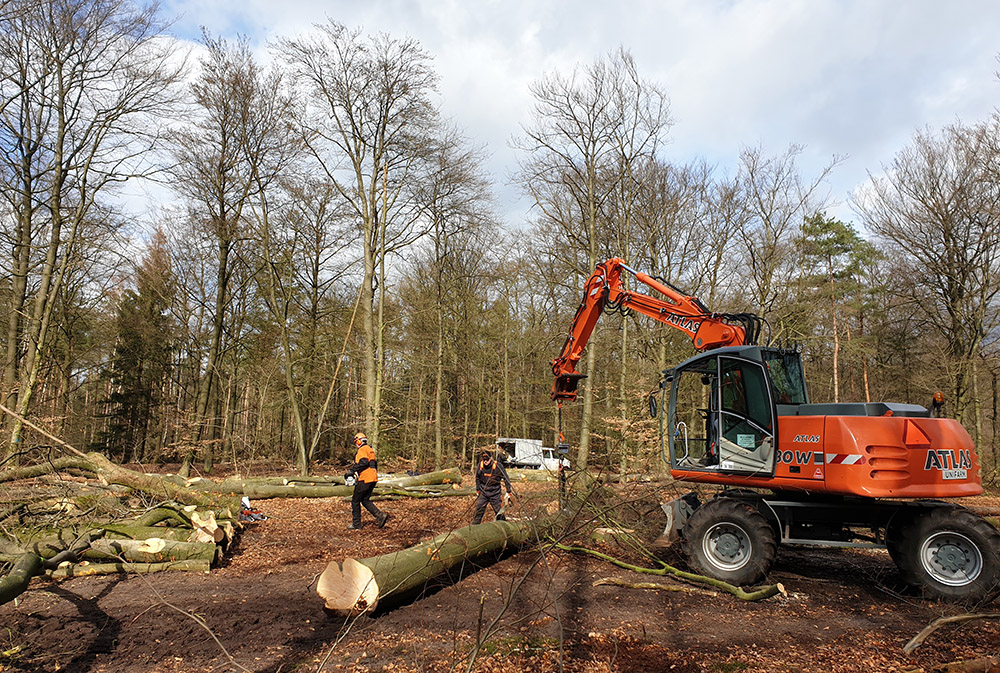
The trees are weighed – Photo: Marleen Vos
In the long term
“It is a unique experiment because it does not take place in a greenhouse or climatic chamber. It concerns actual interventions, through which we will be better able to understand the impact,” says Sterck. In the future, he wants to extend the research to include the impact on water management, biodiversity, and soil life in the forest. “Forests are a sustainable source of raw materials, but when using it, you need to consider how to sustain the system in the long term. And here we’re talking centuries.”
Read more:
- About this project: Extensive study into sustainable logging
- The Forest Ecology and Forest Management Group aims to understand the structure and functioning of forest ecosystems and their responses to changing environmental, biotic and social conditions, and to apply this knowledge for the development of sustainable forest resource use systems
- Read this article in Dutch

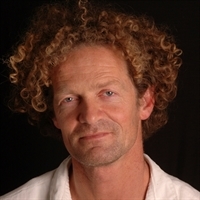
why not grow hemp instead of trees and return the hemp nutrients to the soil keeping the fibre and the straw
Hemp would not provide the recreational value of the forest. And what about water management?